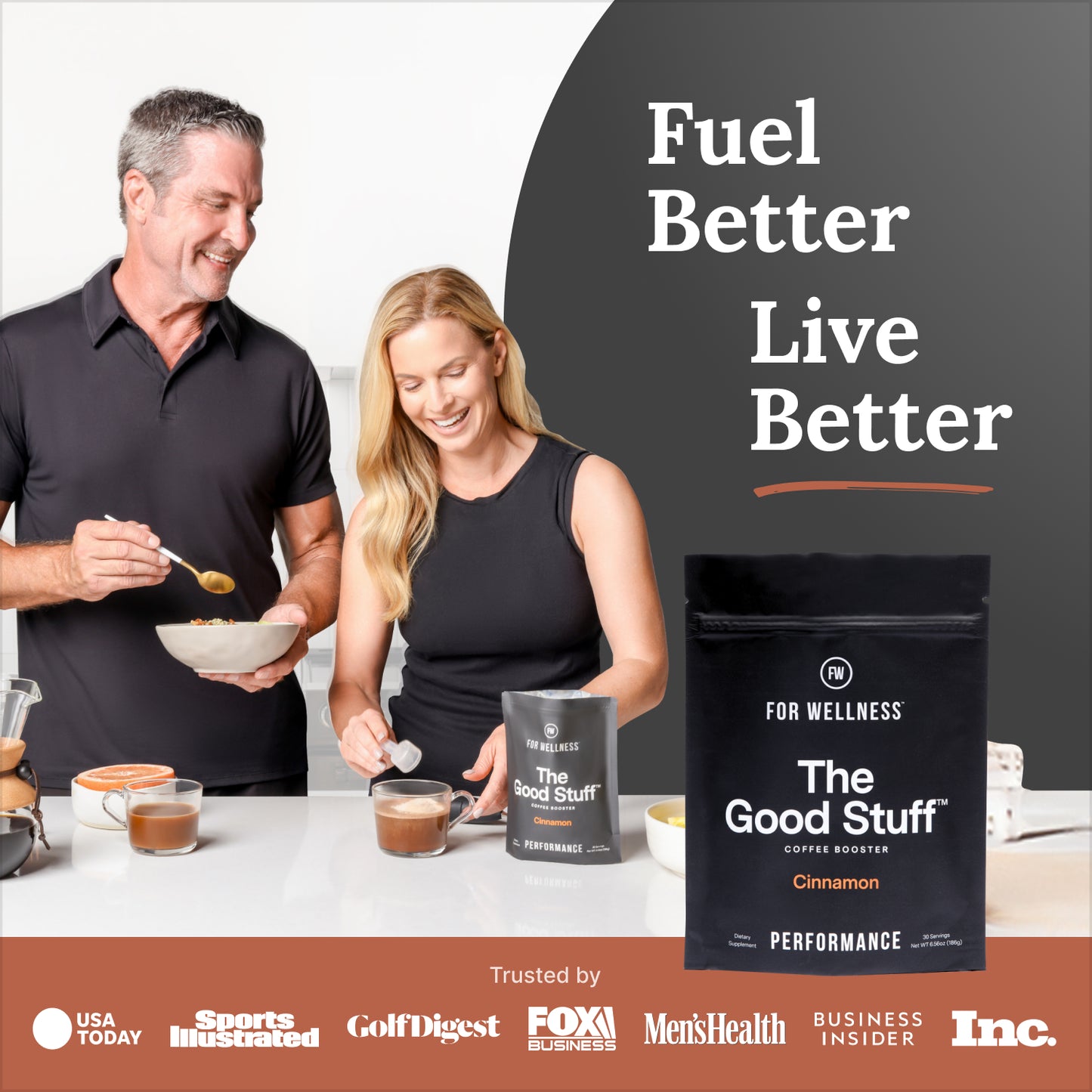Amino acids serve as the foundation of your very existence. That might sound a little dramatic, but it's true!
Allow us to explain.
What Are Amino Acids?
Amino acids are molecules that act as the building blocks of proteins. What distinguishes one amino acid from another is its distinct arrangement of atoms, forming a backbone structure with a unique side chain called an R-group.
This diversity in side chains gives rise to the remarkable versatility of different amino acids. There are 20 standard amino acids, each with specific chemical properties and biological functions. These 20 amino acids are further classified into two main categories based on their role in protein production: essential amino acids (which include branched-chain amino acids) and non-essential amino acids.
Essential Amino Acids
These are amino acids that the body cannot make on its own in sufficient quantities and thus must be obtained from dietary sources. They include histidine, isoleucine, leucine, lysine, methionine, phenylalanine, threonine, tryptophan and valine.
Branched-Chain Amino Acids
Of the nine essential amino acids listed above, three are considered branched-chain amino acids (BCAAs): leucine, isoleucine, and valine.
BCAAs are named for their molecular structure, which includes a “branch” of carbon atoms. They are unique among amino acids because they’re metabolized primarily in muscle tissue rather than in the liver, like other amino acids.
BCAAs play several important roles in the body, including:
- 💪 Increase Muscle Growth: BCAAs, particularly leucine, are key stimulators of muscle protein synthesis, the process that builds new muscle tissue. This makes BCAA supplements popular among athletes and individuals looking to support muscle growth and recovery.
- 😴 Reduce Exercise Fatigue: Supplementing with BCAAs has been shown to reduce fatigue, which can improve athletic performance.
- 😊 Reduce Muscle Soreness: Some research suggests that BCAA supplementation may help reduce muscle soreness after exercise.
Non-Essential Amino Acids
There are also non-essential amino acids that can be made by the body from other compounds and are, therefore, not required to be obtained through the diet. These include alanine, arginine, asparagine, aspartic acid, cysteine, glutamic acid, glutamine, glycine, proline, serine, and tyrosine.
Other Amino Acids
While essential and non-essential amino acids are crucial for survival, there are also amino acids that are not strictly essential for survival but may support health in other ways. For example, theanine, primarily found in tea leaves, has gained attention for its potential benefits for anxiety and stress relief, improved sleep, and increased focus.
What Do Amino Acids Do in the Body?
Amino acids serve as the foundational units of proteins — the macronutrient that’s responsible for the structure, function, and regulation of virtually every aspect of cellular activity. Through a process called protein synthesis, amino acids are linked together in specific sequences dictated by the genetic code to form chains, which then fold into proteins.
These proteins are then used for several important roles in the body, including:
- Supporting the creation of key enzymes and hormones
- Creation of neurotransmitters, such as serotonin, dopamine, and GABA
- Supporting muscle growth and repair
- Balancing the pH of blood and bodily fluids
- Supporting healthy bones and joints
- Promoting healthy hair, skin, and nails
- Supporting immune function
- Helping you feel full
- Helping you maintain a healthy weight
Simply put, amino acids are essential for the structure, function, and regulation of virtually all biological systems. Yeah — they’re a pretty big deal! 😉
How to Get Amino Acids
As mentioned, some amino acids can be made by the body, while others must be obtained from dietary sources. Here’s how to ensure you’re getting enough:
Nosh on Complete Protein Foods
All proteins are made up of amino acids. When you eat a piece of grilled chicken or a bowl of black bean soup (or anything that contains even a tiny amount of protein), your digestive system breaks the food down into specific amino acids. These amino acids are then absorbed into your bloodstream through the lining of your small intestine. Once in the bloodstream, they can be transported to various parts of your body, where they are used to build and repair tissues and complete various physiological functions.
All whole, animal-based foods, such as meat, fish, eggs, and dairy products, are considered complete proteins, meaning they contain all essential amino acids in sufficient quantities. Certain plant-based foods are also considered complete proteins. These include:
- Soy beans
- Amaranth
- Quinoa
- Hemp seeds
- Chia seeds
- Buckwheat
- Spirulina
Don’t Forgot About Complementary Proteins
You don’t have to get hung up on having a complete protein at every meal, though. It’s entirely possible to meet your amino acid requirements by consuming a variety of incomplete protein sources throughout the day.
For instance, if you have lentils as part of your lunch (which are high in lysine but low in methionine) and then rice with dinner (which is low in lysine but high in methionine), the combination of these two meals ensures that you’re getting a balanced intake of amino acids. Rice with beans is another classic combo that makes a complete protein. These are called complementary proteins. Essentially, they complement each other’s amino acid profiles to form a complete protein.
Bottom line? Mixing and matching different types of protein-rich foods can help provide a balanced amino acid profile and maximize nutrient intake.
Psst! You can also get a dose of amino acids by enjoying our Superfood Bites. These crave-worthy, whole-food bites contain organic blanched almonds and organic peanuts — good sources of amino acids.
Pick Up the Slack with Amino Acid Supplements
In certain situations where dietary intake may be inadequate or specific health goals require targeted supplementation, amino acid supplements can be used to top up your amino acid reserves. These supplements typically come in the form of individual amino acids or amino acid blends and can be found in various forms like capsules, tablets, powders, or liquids.
You can also find amino acids in certain performance supplements, including The Good Stuff™ and The Good Stuff™ Focus! (More on this in a minute.)


The Good Stuff - Performance
-
One scoop will infuse your coffee with healthy ingredients
-
Ditch the bad stuff like sugar, dairy, and artificial creamers
-
Fights inflammation and supports skin and joint health
-
Makes your coffee taste great
Which Amino Acids Are in The Good Stuff™?
The Good Stuff™ is a coffee supplement that contains several performance-packed ingredients, including collagen and L-theanine. Let’s explore how these ingredients benefit your body:
L-Theanine: Promoting a State of Alert Tranquility
Found primarily in tea leaves, L-theanine is an amino acid renowned for its calming and relaxing properties. L-theanine complements the energizing effects of caffeine, reducing the likelihood of caffeine-induced jitters and promoting a smoother, more sustained boost in energy. And get this: paired with caffeine, L-theanine may help increase focus and attention.
Additionally, L-theanine has been associated with anxiety and stress reduction — something pretty much everyone would find helpful.
Collagen: The Body’s Super Glue
While collagen itself is not an amino acid, it’s a protein that’s composed of amino acids, most notably glycine, proline, and hydroxyproline. In fact, collagen is the most abundant protein in the human body, making up a significant portion of your skin, bones, muscles, tendons, and ligaments. It’s often referred to as the “glue” that holds the body together. The amino acids in collagen provide structural support and strength to various tissues and organs, contributing to their elasticity, firmness, and integrity.
As humans age, collagen production naturally declines, leading to common signs of aging, such as wrinkles, sagging skin, and joint stiffness.
While the body naturally produces collagen, it can also be obtained through dietary sources and supplements, like The Good Stuff™ and The Good Stuff™ Focus. (The Good Stuff™ Focus is a sister product to the original blend and contains theobromine, a cocoa extract that can boost focus and learning.)
Maximize Your Health with Amino Acids
Whether through complete protein sources, complementary protein combinations, or targeted supplementation like The Good Stuff™, incorporating amino acids into your daily routine can help ensure your body and mind are firing on all cylinders.
We’ll leave you with a wrap-up of what we’ve discussed in this article:
- Amino acids are fundamental to several bodily functions, serving as the building blocks of proteins.
- They’re categorized into essential and non-essential amino acids, both crucial for physiological processes.
- There are also other types of amino acids, like theanine, that aren’t necessary for survival, but may enhance your health in positive ways.
- Essential amino acids must be obtained from the diet, while non-essential ones can be made by the body.
- Supplements can be used to boost amino acid intake.
- The Good Stuff™ and The Good Stuff™ Focus, which contain L-theanine and collagen, not only enhance the taste of your coffee but also provide your body with the building blocks it needs to thrive.
Have you had your amino acids today?
Written by Katie Koschalk, a health and wellness writer, certified holistic nutritionist, and certified personal trainer based in California.















